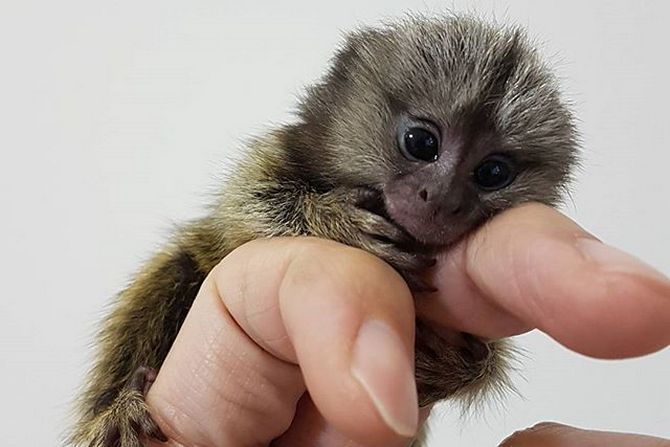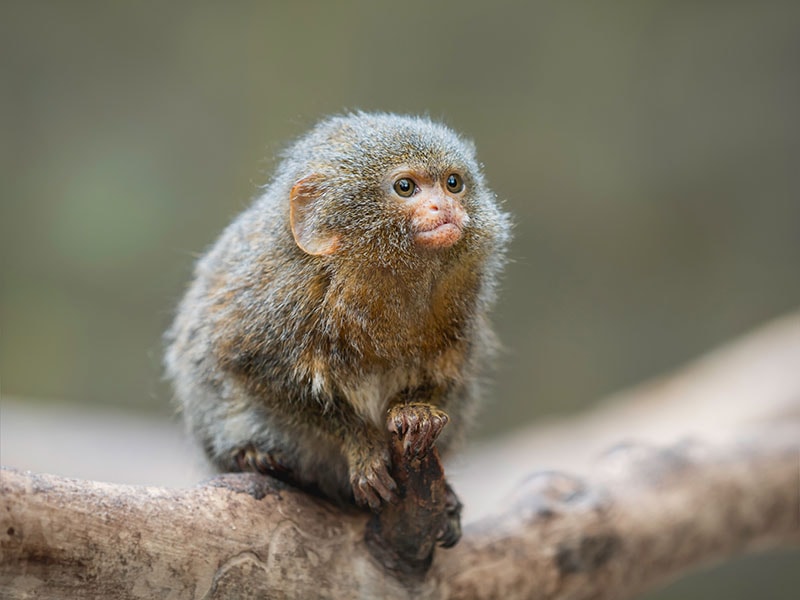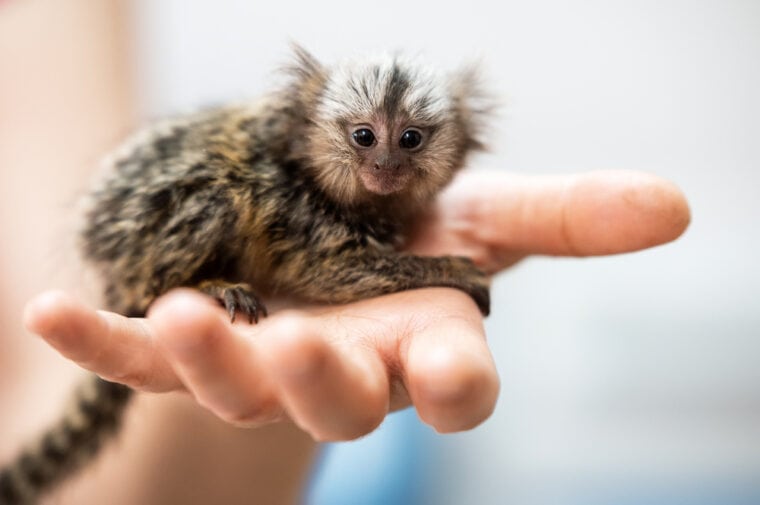Finger monkeys, also known as pygmy marmosets, are small primates that belong to the Callitrichidae family. Their scientific name is Callithrix pygmaea. These small monkeys are native to the rainforests of South America, particularly the Amazon Basin in countries such as Brazil, Peru, Ecuador and Colombia.
Finger monkeys are the smallest species of monkey in the world, with adults typically weighing around 100 to 150 g (3.5 to 5.3 oz) and only 14 to 16 cm (5.5 to 6.3 in) in length, excluding the tail. They have a unique adaptation that allows them to grasp branches and other objects with their long, slender fingers, hence their common name “finger monkeys”.
These primates have distinctive physical characteristics. They have a dark gray or brown coat with white fur around the face, ears and throat. Their tail is longer than their body and is used for balance when they jump and move through trees. Finger monkeys also have specialized teeth called “comb teeth”, which they use for grooming themselves and for extracting insects and tree sap.
Finger monkeys are highly social animals and live in small family groups consisting of a breeding pair and their offspring. They communicate through a variety of vocalizations, including whistles, trills, and chattering sounds. They are primarily arboreal, spending most of their lives in the shade of trees, where they feed on tree sap, fruit, insects, and small vertebrates.
Because of their small size and adorable appearance, finger monkeys have become popular as exotic pets. However, it is important to note that they are wild animals and have specific care requirements that are difficult to meet in a domestic setting. Additionally, capturing and keeping wild finger monkeys as pets may contribute to their decline in the wild. It is generally recommended to appreciate these fascinating creatures in their natural habitat and to support conservation efforts to protect their populations.

FAQs: Frequently Asked Questions
Question: What are finger monkeys?
Answer: Finger monkeys, also known as pygmy marmosets, are the smallest species of monkey in the world. They are native to the rainforests of South America, especially the Amazon Basin.
Question: How small are finger monkeys?
Answer: Adult finger monkeys typically weigh about 100 to 150 g (3.5 to 5.3 oz) and are about 14 to 16 cm (5.5 to 6.3 in) in length, excluding their tail. They are unbelievably tiny and adorable!
Question: Can Finger Monkeys be kept as pets?
Answer: While finger monkeys may seem attractive as pets, they are wild animals with special care requirements. They are generally not recommended as pets because of their complex needs, the potential for illegal trade, and the impact on their populations in the wild.
Question: What do finger monkeys eat?
Answer: Finger monkeys have a varied diet consisting of tree gum, tree sap, plant sap, fruit, nectar, flowers, insects, spiders, small vertebrates, and bird eggs. They have specialized teeth to pierce tree bark and extract the tree’s gum and sap.
Question: Are Finger Monkeys Endangered?
Answer: Finger monkeys are not currently classified as endangered. However, they face threats due to habitat loss, deforestation, and the illegal wildlife trade. It is important to support conservation efforts to ensure their long-term survival.
Question: How do finger monkeys communicate?
Answer: Finger monkeys communicate through a variety of vocalizations, including soft whistles, trills, and chattering sounds. They use these vocal signals to convey messages, maintain social bonds, and alert others to potential threats.
Question: Do finger monkeys live in groups?
Answer: Yes, finger monkeys live in small family groups called troops. A typical troop consists of a breeding pair, their offspring, and sometimes other related adult members. They display cooperative caregiving and social interaction within these family units.
Question: Where can finger monkeys be found?
Answer: Finger monkeys are found in the rainforests of South America, mainly in parts of Brazil, Peru, Ecuador, Colombia, and Bolivia. They inhabit the lowland rainforests of the Amazon region.
Question: How long do finger monkeys live?
Answer: In the wild, finger monkeys have an average lifespan of about 12 to 15 years. In captivity, where they receive special care, they can live a little longer, up to 20 years.
Question: Why are finger monkeys important?
Answer: Finger monkeys play an important role in their ecosystem as pollinators, seed dispersers, and prey for predators. They contribute to the overall biodiversity and health of the rainforest ecosystem, making their conservation essential.
Popularity as exotic pets and their unique characteristics
Finger monkeys, or pygmy marmosets, have gained popularity as exotic pets because of their unique characteristics and adorable appearance. Here are some reasons why they have become popular as pets:
- Size: Finger monkeys are the smallest monkeys in the world, making them incredibly cute and attractive to animal lovers. Their small size and delicate features make them irresistible to many.
- Adaptability: Despite their small size, finger monkeys have remarkable agility and dexterity. Their long, thin fingers allow them to grip objects tightly, earning them the name “finger monkey”. This feature adds to their charm and makes them attractive to watch.
- Intelligence: Finger monkeys are highly intelligent primates. They display complex social behavior, problem-solving abilities, and excellent memory skills. This intelligence can make them attractive pets, as they can learn tricks and form strong bonds with their owners.
- Vocalization: These small primates have a wide range of vocalizations, including soft whistles, trills, and chattering sounds. Their vocalizations add to their appeal as pets, as they can communicate and interact with their owners in unique ways.
However, it is important to consider the following factors before considering a finger monkey as a pet:
- Special Care: Finger monkeys have specific dietary and environmental requirements that can be challenging to meet in the home. They require a specialized diet consisting of fruit, insects and tree gum, as well as a large and rich enclosure that mimics their natural habitat.
- Social Needs: Finger monkeys are highly social animals that live in family groups. They need to be provided with social contact through companionship with other finger monkeys or through appropriate human contact. Separation can lead to stress and behavioral problems.
- Legality and Conservation Concerns: Regulations regarding the ownership of finger monkeys as pets vary from country to country and even within regions. It is important to check local laws and regulations before considering a finger monkey as a pet. Additionally, capturing wild finger monkeys for the pet trade may be contributing to their decline in the wild, and it is important to support conservation efforts instead.

In conclusion, while finger monkeys have unique characteristics that make them attractive as exotic pets, it is important to thoroughly research their care needs, consider their social needs, and ensure compliance with local laws and regulations. Responsible ownership and support of conservation efforts are vital to the protection of these fascinating creatures.

Understanding Finger Monkeys: An Overview
Finger monkeys, scientifically known as pygmy marmosets (Callithrix pygmaea), are small primates native to the rainforests of South America. Here is a general description of their appearance and size:
- Size: Finger monkeys are the smallest monkeys in the world. Adults typically weigh around 100 to 150 g (3.5 to 5.3 oz), and have a body length of about 14 to 16 cm (5.5 to 6.3 in), excluding the tail.
- Body: They have slim bodies and delicate bone structures. Their limbs are proportionally long and slender, which allows them to move around the tree canopy with agility.
- Coat: Finger monkeys have soft and dense fur that covers their body. Color can vary, but they typically display a dark brown or gray coat. They have distinct white fur around their face, ears, and throat, creating a wonderful contrast.
- Tail: The length of their tail is more than the length of their body. The tail is long, thin, and flexible, which means it can grasp objects and wrap around them, aiding in balance and movement through trees.
- Head and Face: The head is small, round, and expressive, with large eyes. His facial features include black rings around the eyes and a pink face with a black nose.
- Hands and feet: Finger monkeys have long, thin fingers and opposable thumbs, which enable them to grasp objects with precision. They also have special adaptations including claws and tactile pads on their feet to aid in climbing and clinging to tree branches.

Overall, the appearance of finger monkeys is adorable and distinctive due to their small size, long limbs, expressive eyes, and unique coloration. Their compact and delicate features make them highly attractive to animal lovers.
Finger Monkeys Natural Habitat And Distribution In The Wild
Finger monkeys, or pygmy marmosets, are native to the lush rainforests of South America, particularly the Amazon Basin. They can be found in several countries including Brazil, Peru, Ecuador, Colombia, and parts of Bolivia.
Their natural habitat includes tropical rainforests, dense vegetation, and riverine areas. They inhabit primary and secondary forests as well as flooded forests near water sources. These environments provide them with essential resources such as food, shelter, and social interaction for survival.
Finger monkeys are arboreal animals, spending most of their lives in the shade of trees. They have adapted to this habitat and have many characteristics that allow them to thrive in their natural environment. Their long, slender fingers and opposable thumbs enable them to move efficiently through trees, leaping easily from one branch to another. Their sharp claws and tactile pads on their hands and feet give them a secure grip on tree trunks and branches.
In the wild, finger monkeys primarily eat a varied diet. They consume tree gum, which they extract by piercing tree bark, as well as tree sap, plant sap, fruit, nectar, and flowers. They also actively seek out insects, spiders, small vertebrates, and bird eggs, and supplement their diets with protein-rich sources.
Due to their specific habitat requirements and distribution, finger monkeys are primarily found in the lowland rainforests of the Amazon region. They depend on the dense vegetation and abundant food sources available in this environment. However, habitat loss and fragmentation pose significant threats to their populations, as large areas of the Amazon rainforest are being cleared for agriculture, logging, and other human activities. Conservation efforts and protection of their natural habitat are vital to ensure the survival of finger monkeys in the wild.

Social Structure and Behavior of Finger Monkeys
- Social interaction: While finger monkeys do not form large groups, they do engage in significant social interaction with their immediate family members. They live in small family units that usually consist of a breeding pair and their offspring. These close family bonds play an important role in their social behaviour.
- Cooperative Care: Within the family unit, finger monkeys exhibit cooperative care, in which all members actively participate in the care and rearing of the young. Siblings, fathers, and other adult members contribute to raising, grooming, and feeding the infants. This shared responsibility promotes the well-being and development of the young monkeys.
- Communication and Singing: Finger monkeys rely on a variety of vocalizations to communicate with their family members. They make low-pitched whistles, trills, and chattering sounds to convey messages and maintain social bonds. These vocal signals allow them to coordinate activities, express emotion, and alert others to potential dangers in their environment.
- Social bonding: Social bonding is important to finger monkeys, even within their small family units. They engage in behaviors such as mutual grooming, where individuals groom each other’s hair. This grooming behavior strengthens social bonds, promotes trust, and contributes to the overall cohesion of the family unit.
- Playful Interactions: Finger monkeys also engage in playful interactions, especially among younger members. Play serves a variety of purposes including social engagement, motor skill development, and stress relief. Through play, finger monkeys learn important social and physical skills that contribute to their overall well-being.
- Personal Relationships: While finger monkeys do not form large social groups, they do develop personal relationships within the family unit. Relationships between marrying pairs, parent-child relationships, and sibling relationships are all important in their social structure. These personal relationships contribute to the social fabric and dynamics within the family unit.
Diet and Feeding Habits of Finger Monkeys
- Varied diet: Finger monkeys have a varied diet that includes both plant-based and animal-based food sources. Their natural diet includes tree gum, tree sap, plant sap, fruit, nectar, flowers, insects, spiders, small vertebrates, and bird eggs. This wide range of foods provides them with essential nutrients for their growth and energy needs.
- Tree gum and sap: One of the notable dietary preferences of finger monkeys is the consumption of tree gum and sap. They skillfully pierce the bark of trees using their specialized teeth, called “comb teeth”. This gives them access to the nutritious tree gum and sap, which form an important part of their diet. The gum of the tree provides carbohydrates, while the sap contains essential minerals and nutrients.
- Fruit and nectar: Finger monkeys also eat a variety of fruits, juices and flowers found in their habitat. They are adept at locating and extracting these food sources, using their nimble fingers to crack open fruit or reach nectar-filled flowers. The fruits and nectar provide them with important vitamins, sugars and antioxidants.
- Insects and small vertebrates: To supplement their diet, finger monkeys actively hunt insects, spiders, and small vertebrates. They have sharp teeth and agile movements, which allow them to capture and consume these protein-rich food sources. Insects and small vertebrates add essential proteins, fats and other nutrients to their diets.
- Foraging Behavior: Finger monkeys exhibit agile and acrobatic behavior to reach their food sources. They are primarily arboreal, spending most of their time in the shade of trees. They leap from branch to branch, using their long limbs and prehensile tail for balance and maneuverability. They search for fruit, gum, and insects in crevices, bark, and leaves of trees, using their keen eyesight and sense of smell to locate food.
- Specific Customization: Finger monkeys have special adaptations that aid in their foraging and eating habits. Their long, thin fingers and opposable thumbs enable them to grasp and manipulate objects with precision, making it easy to extract gum, crack fruit, and catch insects. Their sharp claws and tactile pads on their hands and feet provide a secure grip on tree trunks and branches during search activities.
The Natural Habitat of Finger Monkeys
The natural habitat of finger monkeys, or pygmy marmosets, is the lush rainforests of South America, mainly in the Amazon basin. Let’s look at the key features of their natural habitat:
- Rainforest Environment: Finger monkeys thrive in tropical rainforests characterized by dense vegetation, abundant plant life and high levels of rainfall. These forests provide a complex and diverse ecosystem that supports a wide range of flora and fauna.
- Geographical Range: Finger monkeys are native to several South American countries, including parts of Brazil, Peru, Ecuador, Colombia, and Bolivia. They inhabit the lowland rainforests of the Amazon region, making this their primary distribution area.
- tree canopy: As arboreal primates, finger monkeys spend most of their lives in the canopy of trees. The rainforest’s towering trees, intertwined branches, and dense foliage create an intricate network of paths and hiding places that finger monkeys navigate with agility.
- Food Source: Rainforests provide a variety of food sources to finger monkeys. They have adapted to eat a variety of items, including tree gum, tree sap, plant sap, fruit, nectar, flowers, insects, spiders, small vertebrates, and bird eggs. The availability of these resources in their habitat is essential for their survival.
- Biodiversity: The rainforest is famous for its incredible biodiversity, and finger monkeys are part of this rich ecosystem. Their natural habitat is filled with a wide range of plant species, insects, birds, mammals and other primates. The intermingling of these species contributes to the delicate balance of the rainforest ecosystem.
- Vertical Structure: The vertical structure of the rainforest, which includes distinct layers from the forest floor to the emergent tree canopy, provides finger monkeys with a variety of micro-habitats to explore. They navigate through the understory, canopy and subcanopy layers, using different resources and finding shelter depending on their specific needs.
- Water Sources: The Amazon rainforest is also known for its extensive river systems, which provide finger monkeys access to water sources. Rivers, streams and other bodies of water are not only important for drinking but also serve as natural boundaries and habitats for various aquatic species.
- Threats and Protection: The natural habitat of finger monkeys is under threat due to deforestation, habitat fragmentation, and human activities such as logging, agriculture, and infrastructure development. These factors pose significant challenges to the survival of finger monkeys and other rainforest species. Conservation efforts are important to protect their habitat and ensure the preservation of their natural environment.
Understanding the natural habitat of finger monkeys highlights the important role rainforests play in their survival and underscores the importance of conservation to maintain their populations and the overall health of the ecosystem they call home.


Conservation and Protection Efforts
Conservation and conservation efforts are vital to ensuring the survival and well-being of finger monkeys, also known as pygmy marmosets. Here are some of the key initiatives and strategies aimed at conserving these captivating primates:
- Protected Areas and Reserves: Establishing and managing protected areas and reserves is important for the conservation of finger monkeys and their natural habitat. These protected areas provide a safe haven for monkeys, enabling them to live and thrive without the pressures of habitat loss and human disturbance. Strict regulations and enforcement help protect these areas from illegal activities such as logging, hunting, and deforestation.
- Habitat restoration and reforestation: Efforts to restore degraded habitats and promote reforestation are essential for the long-term survival of finger monkeys. Restoration programs focus on replanting native tree species and rehabilitating areas affected by deforestation. By creating suitable habitat, these initiatives contribute to the recovery of finger monkey populations and support the overall health of the ecosystem.
- Community Engagement and Education: Involving local communities in conservation efforts plays an important role in the protection of finger monkeys. Educating communities about the importance of conservation, sustainable land use practices and the economic value of ecotourism can help reduce activities that harm monkey habitat. Involving local communities in conservation initiatives fosters a sense of ownership and encourages their active participation in the conservation of the natural environment.
- Wildlife Monitoring and Research: Regular monitoring and scientific research provide important data on finger monkey populations, their behavior and their ecological needs. This information guides conservation strategies and management decisions. Researchers study their habitat use, feeding habits, breeding patterns and social dynamics to gain a comprehensive understanding of their needs and effectively inform conservation efforts.
- International Cooperation and Legislation: International cooperation between governments, organizations and researchers is essential for the protection of finger monkeys. Collaborative efforts may make it possible to establish cross-border conservation areas, share best practices, and enforce legislation to combat illegal wildlife trade and habitat destruction. International agreements and conventions, such as the Convention on International Trade in Endangered Species of Wild Fauna and Flora (CITES), help regulate and control the trade of finger monkeys and their derivatives.
- Sustainable Tourism and Responsible Pet Ownership: Promoting sustainable and responsible tourism practices can generate economic benefits while minimizing negative impacts on finger monkeys and their habitats. Contribute to their conservation by encouraging travelers to engage in wildlife viewing activities that respect the monkeys’ natural behavior and well-being. Similarly, promoting responsible pet ownership discourages the illegal trade and capture of finger monkeys, which can have harmful effects on their populations in the wild.
By implementing these conservation and protection efforts, we can ensure the long-term survival of finger monkeys, protect their natural habitat, and their presence as an integral part of the rich biodiversity found in the rainforests of South America can appreciate.
Conclusion:
Encouraging the public to support conservation efforts and to appreciate the natural beauty of finger monkeys in their habitat is vital to their long-term survival. Here are some reasons and ways to motivate individuals to get involved:
- Conservation Awareness: Spread awareness about the importance of conservation and the specific threats finger monkeys face. Educate others about the impact of habitat loss, deforestation, and the illegal wildlife trade on their populations. Highlight their role in maintaining the delicate balance of the ecosystem and stress the need to protect their habitat for future generations.
- Support Protection Organization: Encourage individuals to support reputable conservation organizations that focus on protecting rainforest habitats and endangered species. These organizations work tirelessly to implement conservation initiatives, conduct research, and raise awareness. Charities and volunteer opportunities provide vital support for their efforts.
- Responsible Travel: Promote responsible and sustainable travel practices when visiting areas where finger monkeys live. Choose tour operators and accommodations that prioritize conservation and respect for wildlife. Engage in ethical wildlife viewing activities that prioritize the well-being and natural behavior of finger monkeys. By supporting responsible tourism, you contribute to the local economy while reducing disturbance to their habitat.
- Learn and share knowledge: Encourage the public to learn more about finger monkeys, their behavior and their habitat. Share interesting facts, stories and photos through social media, blogs or in-person conversations. By sharing knowledge, you can foster a greater appreciation for their natural beauty and inspire others to take action in support of their conservation.
- Advocate for Sustainable Practices: Promote sustainable land use practices such as sustainable agriculture and responsible logging to reduce habitat destruction. Advocate for sustainable development policies that consider the needs of wildlife and their habitats. Support initiatives that encourage reforestation, habitat restoration, and the creation of protected areas.
- To inculcate respect for wildlife: Encourage individuals to respect and appreciate wildlife in their natural habitats. Emphasize the importance of observing from a distance, avoiding feeding or touching wildlife, and refraining from buying or keeping finger monkeys as pets. By fostering a sense of respect and appreciation for these animals, we can contribute to their conservation by allowing them to thrive undisturbed in their natural environment.
Remember, it is a collective responsibility to support conservation efforts and appreciate finger monkeys in their natural habitat. Together, we can make a positive impact and ensure the conservation of these fascinating creatures for generations to come.

